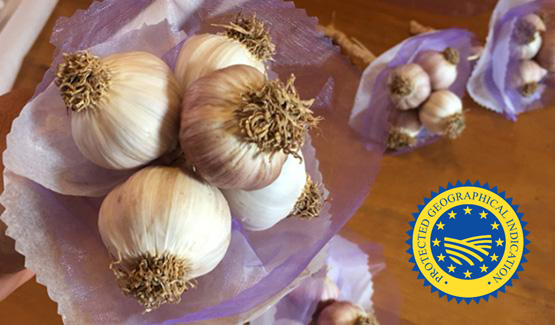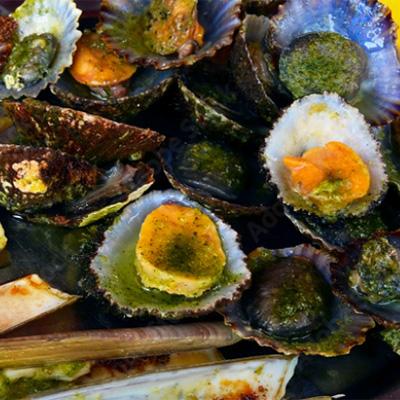Alho da Graciosa PGI garlic originates from the Northern Atlantic Ocean island of Graciosa, which is part of the Azores archipelago, one of the autonomous regions of Portugal.
Alho da Graciosa PGI garlic is presented in the form of dried bulbs, either individually or in braids. The cloves’ medium-low intensity aroma sets them apart, releasing their subdued delicate scent even when uncrushed.

Origins
Graciosa is the northernmost of the islands making up the Azores archipelago, one of the autonomous regions of Portugal. It was in the early 15th century that the island attracted its first settlers, who soon appreciated the benefit of the rainfall pattern and fertile soil of their new home on fruit and vegetable growing. The garlic harvested by the islanders – mostly subsistence farmers – stood out from other crops.
Generation after generation, Graciosa’s garlic has been improved upon, leading to the fine produce it is today. Not only did producers select the best specimens for propagation in order to preserve its main characteristics such as colour and size, they also took great care to ensure that no cultivars were brought in from other regions.
Alho da Graciosa PGI garlic is characterised by its medium-low intensity aroma, even uncrushed. Its intense, highly pleasant flavour with little aftertaste makes it a sought-after product, notable for its distinctive taste and subtle aroma. Culinary specialties enjoyed on the island can be prepared or seasoned using Alho da Graciosa, such as the famous molhanga sauce served with fresh fish, the fish dish molho à pescador, the typical Graciosa sausage (linguiça da Graciosa) or grilled limpets (lapas grelhadas).
Thanks to its celebrated produce, Alho da Graciosa PGI, the island of Graciosa is known as the “Terra do Alho”, or “garlic country” to this day.
Alho da Graciosa PGI gained its European Protected Geographical Indication status in 2021.
Production
Alho da Graciosa PGI is a plant crop that belongs to the garlic species of Allium sativum L. All the steps in its production take place on the island of Graciosa in the Azores archipelago, from the selection of the best garlic cloves for planting, to cultivation and harvesting.
Much like that of the other islands in the archipelago, Graciosa’s climate has temperate oceanic characteristics. However, it has the lowest rainfall in the Azores, with May and August being the driest months. The island’s landscape features low-altitude plains that are sheltered from strong winds and get plenty of sunshine.

Alho da Graciosa PGI garlic’s growing conditions have benefited from a blend of climatic conditions and natural characteristics. The volcanic soils, with a slightly acidic or neutral pH, are rich in micronutrients such as zinc and iron, which are essential for the development of the young plants and for chlorophyll formation and photosynthesis. The average soil pH, combined with the low rainfall and exposure to sunlight, is conducive to the formation of allicin, the principal antimicrobial constituent of Alho da Graciosa PGI, and conferring food-preserving properties.
Alho da Graciosa PGI garlic is presented in the form of dried bulbs, either individually or in braids, each with a diameter of at least 3 cm, measured across the peeled bulb. The bulbs, which are ovoid in shape and wrapped in various layers of white outer skins that are easy to remove, consist of cloves with a firm, smooth texture encased in reddish pink skins.
The distinctive characteristics of Alho da Graciosa PGI mean demand is not restricted to the regional market. On the contrary, it can also be found elsewhere in Portugal, where it is used by some of the country’s top chefs, who make the most of its culinary qualities without the risk of excessive smell or flavour.
More information
Alho da Graciosa PGI – legal specifications


